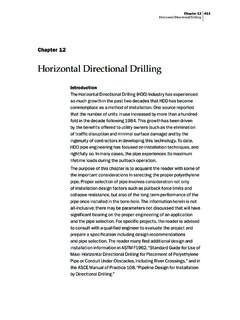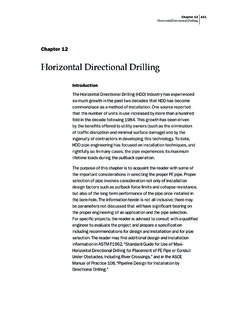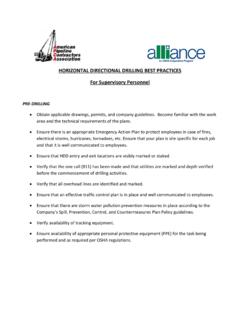Transcription of Guidelines For A Successful Directional Crossing …
1 Guidelines For A Successful Directional Crossing Bid Package Guidelines For A Successful Directional Crossing Bid Package The Directional Crossing Contractors Association (DCCA) has been addressing the issue of what information should be made available to contractors and engineers so that future projects proceed as planned. Crossings of rivers and other obstacles using Directional drilling techniques are increasingly being utilized around the world. As in any construction project, it is necessary for the contractor to have as much information as possible to prepare a competitive and comprehensive proposal and to be able to successfully install the Crossing .
2 Better preconstruction information also allows the work to be undertaken more safely and with less environmental OVERVIEWA. DEVELOPMENT AND USES - Originally used in the 1970s, Directional crossings are a marriage of conventional road boring and Directional drilling of oil wells. The method is now the preferred method of construction. Crossings have been installed for pipelines carrying oil, natural gas, petrochemicals, water, sewerage and other products. Ducts have been installed to carry electric and fiber optic cables. Besides Crossing under rivers and waterways, installations have been made Crossing under highways, railroads, airport runways, shore approaches, islands, areas congested with buildings, pipeline corridors and future water TECHNOLOGY LIMITS -The longest Crossing to date has been about 6,000 ft.
3 Pipe diameters of up to 48 in. have been installed. Although Directional drilling was originally used primarily in the Gulf Coast through alluvial soils, more and more crossings are being undertaken through gravel, cobble, glacial till and hard ADVANTAGES - Directional crossings have the least environmental impact of any alternate method. The technology also offers maximum depth of cover under the obstacle thereby, affording maximum protection and minimizing maintenance costs. River traffic is not interrupted, as most of the work is confined to either bank.
4 Directional crossings have a predictable and short construction schedule. Perhaps most significant, Directional crossings are in many cases less expensive than other TECHNIQUE1. Pilot Hole - A pilot hole is drilled beginning at a prescribed angle from horizontal and continues under and across the obstacle along a design profile made up of straight tangents and long radius arcs. A schematic of the technique is shown in Figure 1. Concurrent to drilling pilot hole, the contractor may elect to run a larger diameter "wash pipe" that will encase the pilot drill string.
5 The wash pipe acts as a conductor casing providing rigidity to the smaller diameter pilot drill string and will also save the drilled hole should it be necessary to retract the pilot string for bit changes. The Directional control is brought about by a small bend in the drill string just behind the cutting head. The pilot drill string is not rotated except to orient the bend. If the bend is oriented to the right, the drill path then proceeds in a smooth radius bend to the right. The drill path is monitored by an electronic package housed in the pilot drill string near the cutting head.
6 The electronic package detects the relation of the drill string to the earth's magnetic field and its Guidelines For A Successful Directional Crossing Bid Package inclination. This data is transmitted back to the surface where calculations are made as to the location of the cutting head. Surface location of the drill head also can be used where there is reasonable Preream - Once the pilot hole is complete, the hole must be enlarged to a suitable diameter for the product pipeline. For instance, if the pipeline to be installed is 36 in.
7 Diameter, the hole may be enlarged to 48 in. diameter or larger. This is accomplished by "prereaming" the hole to successively larger diameters. Generally, the reamer is attached to the drill string on the bank opposite the drilling rig and pulled back into the pilot hole. Joints of drill pipe are added as the reamer makes its way back to the drilling rig. Large quantities of slurry are pumped into the hole to maintain the integrity of the hole and to flush out Pullback - Once the drilled hole is enlarged, the product pipeline can be pulled through it.
8 The pipeline is prefabricated on the bank opposite the drilling rig. A reamer is attached to the drill string, and then connected to the pipeline pullhead via a swivel. The swivel prevents any translation of the reamer's rotation into the pipeline string allowing for a smooth pull into the drilled hole. The drilling rig then begins the pullback operation, rotating and pulling on the drill string and once again circulating high volumes of drilling slurry. The pullback continues until the reamer and pipeline break ground at the drilling For A Successful Directional Crossing Bid Package II.
9 LAYOUT AND DESIGNA. ACCESS - Heavy equipment is required on both sides of the Crossing . To minimize cost, access to either side of the Crossing should be provided with the least distance from an improved road. Often the pipeline right-of-way is used for access. All access agreements should be provided by the owner. It is not practical to negotiate such agreements during the bid process. B. WORK SPACE1. Rig Side -The rig spread requires a minimum 100-ft. wide by 150-ft. long area. This area should extend from the entry point away from the Crossing , although the entry point should be at least 10 ft inside the prescribed area.
10 Since many components of the rig spread have no predetermined position, the rig site can be made up of smaller irregular areas. Operations are facilitated if the area is level, hardstanding and clear of overhead obstructions. The drilling operation requires large volumes of water for the mixing of the drilling slurry. A nearby source of water is necessary (Figure 2). 2. Pipe Side - Strong consideration should be given to provide a sufficient length of work space to fabricate the product pipeline into one string. The width will be as necessary for normal pipeline construction although a work space of 100-ft.





